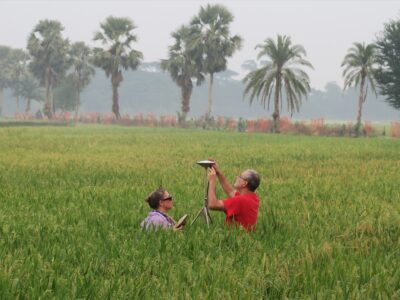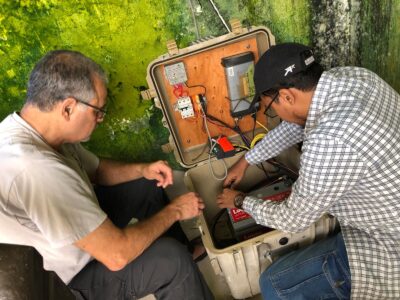
On Saturday, we finished up work at the site. Even at the last minute, it threw some challenges at us. We began the day with out reduced group eating breakfast down the street. We could no longer take the mediocre food at the hotel. Dhiman and Babu had been eating there for days. Besides paratha, they also made tandoor roti. The bread was crisp on one side and fluffy on the other. Still, the breakfast vegetables in the south had more potato and less cabbage. After finding a shop open early for some last minute needs, like extra electrical wire, we headed out to the site. We started by installing the electrical system for the house while Scott D. continued the calibration of the wells and training of Hafizur. The roof was too flimsy for us to climb on, but Dhiman was able to wire the solar panel onto the screws holding the thin tin roof. Then, we put in the power regulator, battery, voltage inverter for charging the equipment, and most importantly two 12-volt 5W compact fluorescent bulbs for the family. Not too much light, but better than the kerosene lamps and LEDs they had, plus a light switch on the wall. The family is thrilled. They are the first on the block to get powered.
Talking to them, we found out they have lived there for 10 years. The river used to by 600m wide and has now shrunk to a small creek. That is why the bridge is so big for such a little river. As it shrank, it exposed new land and the family moved here from the village to start their shrimp farm. I will have to research the evolution on satellite imagery when I get back. The more I learn about the area, the more excited I am about this site. It is actively evolving and should produce fascinating data.

Next, Scott N. and I went to surveying the pads. Did fine for the first few, but then we found the level could not focus very far. Something is wrong with it. We didn’t notice in Jamalganj because all the wells were in a circle around the GPS. With the linear arrangement here, we cannot focus on the far ones, but there is nothing we can do about it. We will have to have the unit repaired back in the states. Then came the attaching of the GPS antenna. All went as planned. Scott D. finished his work. We are done at the well site, just have to hook up the GPS receiver at the house. However, after we did, the receiver had no signal from the antenna. Something is wrong with the cable. We have to check it to find the break. Unfortunately, besides the connector at the receiver, the others are at the antenna, where the scaffolding is now gone and on top of the solar panel pipe. We have a ladder for the GPS pillar. Scott N. is able to climb the pole, demonstrating that our cement the bottom is strong. Finally we found the problem. The connectors at the antenna and receiver need to be stripped differently than the ones at the lightning protector. We don’t have a tool for the correct depth, but a caliper and knife work fine. We redid them and, behold, everything is working. We now know the antenna position to a few meters. After processing, we will know it to a few millimeters. Everything is done. The younger kids are back from school and I take a group photo of the family. We will bring them a framed print next year.

Yesterday, was time for leaving Khulna. We tried a new place for breakfast and after checking out, we went back to the site a final time to load the equipment onto a van for the trip to Dhaka. The mentally ill neighbor showed up, but she was quickly and expertly eased away. We made our final farewells and left for the long ride to Dhaka. Along the way we a tourist stop in Bagherat to visit the famous 60-dome mosque built about 500 years ago by Khan Jahan Ali. It actually has 60 columns inside and a total of 81 domes. The columns are built of stone and they had to be transported a long way to get here. It is beautiful and still being used. We wish we had more time to see other sights in the world heritage city, but there is still a long way to go to Dhaka, including the ferry crossing of the Padma. This time we got to see it in daylight and the sun set as we were crossing. Little traffic most of the way until we hit Dhaka. I did not miss inching through the streets. Babu finds some shortcuts and we arrive at the university about 8:30 PM. We have to wait a little while for the other van, unpack everything, and then over to the familiar Ambala Inn to meet Steve Goodbred and Kevin. Yet, another late dinner. Now just a couple days of alternating meetings and traffic in Dhaka, and then home. It was a lot of hard work and long days, to say nothing of the strain on our families. We learned a lot about installing these systems and about Bangladesh. Now, we could probably nail all 12, but we are feeling very satisfied with our accomplishments.


P.S. Today, between meetings, Humyun was interviewed for a TV show to air Thursday. Both Nano and I were interviewed, too.





Man, sounds like you guys put some serious work in! Great job, I wish I had your kind of motivation!